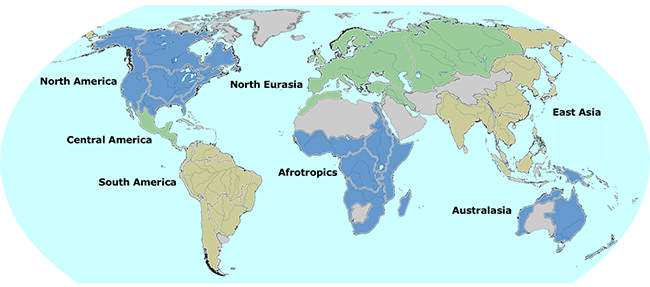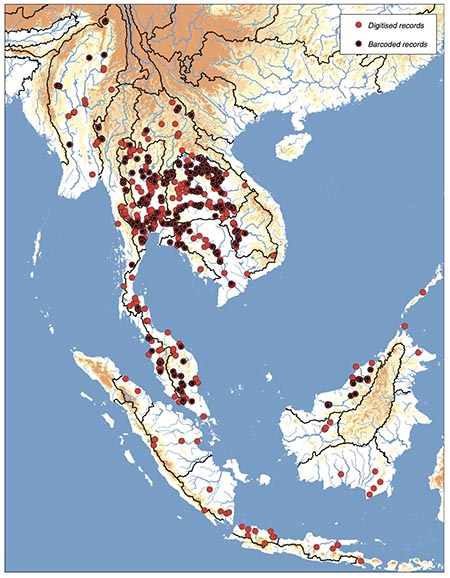| Page last updated
30 June 2021 |
2021 MUSSELp Publications & Presentations
A 'big data' approach to global freshwater mussel diversity (Bivalvia: Unionoida), with an updated checklist of genera and species
by Daniel L. Graf & Kevin S. Cummings
Published 2021, Journal of Molluscan Studies 87(1): eyaa034. Click here for online access.

The objective of this review is to update our previously published checklist of Recent freshwater mussel species and genera (Graf & Cummings, 2007, J. Molluscan Stud.: 291–314) to reflect the new data and research findings that have accumulated over the last decade. The MUSSEL Project Database was developed to synthesize the available taxonomic nomenclature, species ranges and published taxonomic hypotheses on genus–species combinations and synonymy. We have found 4,988 available species-group level nominal species representing 958 valid species in 192 genera worldwide, an increase of 118 species since 2007. The current patterns of species richness are discussed with regard to both taxonomy and geography, as is the general flux in the number of species recognized over time. A checklist is provided herein, with a bibliography to key faunistic and taxonomic references. The full dataset is maintained and updated on the MUSSEL Project Web Site (http://mussel-project.net/). |
Taxonomic revision of a radiation of South-east Asian freshwater mussels (Unionidae : Gonideinae : Contradentini+Rectidentini)
 by John M. Pfeiffer, Daniel L. Graf, Kevin S. Cummings & Lawrence M. Page by John M. Pfeiffer, Daniel L. Graf, Kevin S. Cummings & Lawrence M. Page
Published 2021, Invertebrate Systematics 45: 394-470. Click here for online access.
The tribes Contradentini and Rectidentini (Unionidae) comprise a diverse clade of freshwater mussels endemic to South-east Asia. Our understanding of the diversity and phylogeny of this radiation has improved dramatically in recent years, but this systematic transformation has not yet benefited from comprehensive museum sampling or phylogenomic methods. A synthetic taxonomic revision of the Contradentini+Rectidentini that leverages these useful and accessible methods is needed. We set out to (1) generate a phylogenomic reconstruction of the supraspecific relationships of the Contradentini+Rectidentini using anchored hybrid enrichment, (2) revise the taxonomy and geographic boundaries of the generic and species-level diversity of the radiation, and (3) identify patterns of freshwater mussel diversity and distribution in this clade and discuss the processes that may have precipitated them. Our phylogenomic reconstruction using over 1600 loci, with a total alignment length of over a half a million nucleotides, recovers a well supported phylogeny of the clade that resolves four independent multispecies radiations endemic to the Mekong drainage. We examined, digitised, and imaged 1837 records from 15 natural history museums that provided the necessary data to document the morphological variation and geographic distributions of the focal taxa. We also analysed 860 COI sequences, 519 of which were generated in this study, to better understand the species boundaries and geographic distributions of the recovered clades. We recognise 54 valid species in the tribes Contradentini and Rectidentini, including 9 described herein as new to science. Out of this revision emerged several interesting biogeographic patterns that appear to have resulted from recent stream capture, historical confluence, and intradrainage barriers to dispersal. We hypothesise that these phenomena shaped the diversity and distribution of the Contradentini +Rectidentini, contributing to the formation of several characteristic freshwater mussel provinces in South-east Asia. |
Good, Clean Family Fun: Biodiversity informatics of freshwater bivalves above the species level
by Daniel L. Graf
Presented at the virtual annual meeting of the American Malacological Society, 14-18 July 2021.
Abstract.The MUSSEL Project Database (http://mussel-project.net/) of taxonomy and specimen records for freshwater bivalves (especially the order Unionoida) differs from similar endeavors in the extent to which “taxonomic opinions” are reported. In databasese, a taxonomic opinion is an associative entity relating three pieces of information: a taxonomic work, a named taxon, and a valid taxon that circumscribes the nominal taxon (at least according to the author). For the luddite, a taxonomic opinion is a line in a synonymy. For any taxon, the MUSSELpdb lists the history of use of a described taxon. These data are the basis for the classification in the MUSSELpdb while simultaneously providing users with information about alternative classifications.
For species, the implementation and interpretation of taxonomic opinions is intuitive. Species are real and discoverable natural entities, and even non-systematists are familiar with the concepts of binomial nomenclature and synonymy. It is the rare taxonomic work that doesn’t mention species by name.
Capturing and reporting taxonomic opinions above the species level is more complex for several important reasons, including: 1) recognition of supra-specific taxa is based on tradition and authority; 2) while every mention of a binomial species implies a genus, the application may reflect useful taxonomic information or merely satisfy Article 5 of the ICZN; 3) authors have no obligation to express a formal taxonomic opinion above the genus level; 4) the Principle of Coordination (especially for the family-group level, Art. 36) stretches nominal taxa across multiple taxonomic ranks; and 5) all kinds of useful data relevant to classification are presented as phylogenetic trees that are not amenable to the traditional format of a synonymy.
I have been working to implement solutions to these issues in the Internet version of the MUSSEL Project Database, and my talk will discuss my results to-date. |
|
|